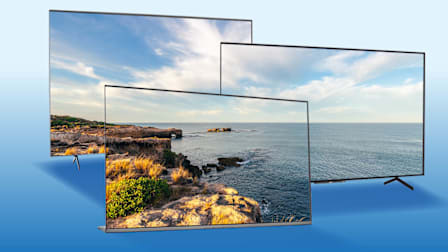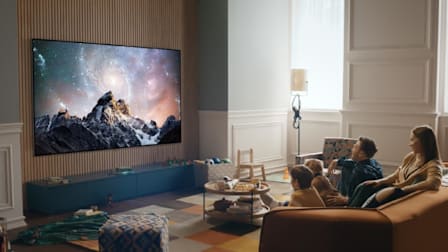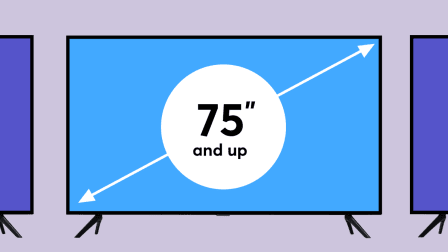Which 2023 LG TV Should You Buy?
This year, LG's best OLED TVs get brighter, but there are fewer choices among LCD-based sets
LG Electronics is one of the major TV brands, and many of its sets—especially OLED TVs and models in its top-tier QNED LCD/LED series—have done very well in our ratings. It also has a more mainstream lineup of TVs that cost less but offer fewer features than those found on the pricier models.
That wide range of TV series and models can sometimes make it tough for consumers to choose the right set for their needs—and budgets. To help make the process a bit easier, we’ll explain some of the new features found in this year’s LG TVs, and what you get—or give up—as you move up and down the company’s lineup.
One quick tip, because you’re likely to find a mix of 2022 and 2023 sets at many retailers right now: LG’s 2023 TVs have the number 3 in the model name (OLED65C3PUA, for example), while last year’s sets have a 2 (OLED65C2PUA).
If you’re shopping, note that new 2023 sets are at their highest prices now, in the spring, while last year’s TVs are likely at their lowest. That means buying a leftover model can be a good option for getting a better TV at a lower price.
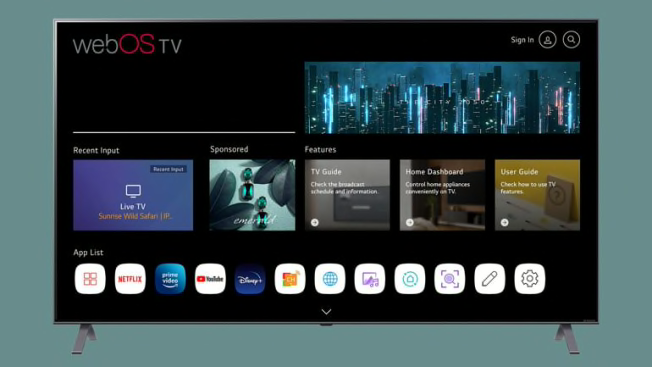
Photo: LG Photo: LG
LG's 2023 OLED TVs
People looking for ultimate picture-quality performance will want to consider one of LG’s OLED TVs. Like last year, the company’s flagship TVs will be ultra-pricey Z-series 8K OLED sets, offered in 77- and 88-inch screen sizes. Right now the company is carrying over last year’s Z2 models but may have a new Z3 series later in the year. But the 77-inch Z2 set costs about $10,000 and the 88-inch Z2 model is priced at $25,000.
That’s why most people looking for top 4K performance may be more interested in the company’s Gallery, or G-series, 4K sets, or the C3 models right below them. Both come with LG’s brighter Evo OLED panels and the company’s most advanced (Alpha 9 Gen 6) processors. Only the Z- and G-series sets this year come with an ATSC 3.0 tuner, which can receive new over-the-air Next-Gen TV signals as they roll out to communities across the country.
If you’re a fan of OLED TVs but are on a tighter budget, there’s also an updated lineup of lower-priced B3-series sets. These are LG’s entry-level OLED sets this year; the company has discontinued last year’s A-series entry-level TVs for 2023.
Here are more details on LG OLED TVs for 2023.
LG G3 Series TVs
We recommend the new G-series models this year mainly for people looking for peak HDR performance and a bit of design flair, and who have deep enough pockets to pay a premium to get it. The G3 sets are noteworthy for being the first OLED TVs to use a new microlens array (MLA) technology, which LG refers to in its marketing material as Brightness Booster Max. Without getting too technical, it involves using billions of tiny convex lenses that let the TV direct more light out toward the viewer while also improving energy efficiency.
The combination, LG says, will make the G3 sets up to 70 percent brighter than the company’s entry-level B-series models. Benefits include better high dynamic range (HDR) performance, improved color saturation, and even wider viewing angles, though all OLED TVs do well in this regard. These sets also get an anti-reflective coating that can reduce reflections in rooms with more ambient light.
LG’s G3 Series sets are available in 55-, 65-, 77-, and 83-inch screen sizes, though the largest model lacks the special brightness booster technology. All the G3 models feature a gapless One Wall Design that lets the TV be placed flush against a wall when mounted. They also come with a longer-than-average 5-year panel warranty.
Of course, the big question is how much extra all this picture-quality goodness is going to cost. Depending on the size, you’ll pay about $4,500 for a 77-inch G3 set and about $3,300 for a 65-inch model. That’s about $700 to $900 more than a similarly sized C3-series TV will cost.
LG C3 Series TVs
As we did last year, we think the C-series models offer the best bang for the buck in LG’s lineup, getting very close to the G3’s performance but at a lower price.
Stepping down to the C3 sets, the main difference is that you lose the special brightness booster technology, along with the ATSC 3.0 tuner, and you get a slightly less powerful sound system. LG tells us that the C3’s measured brightness will be about the same as in last year’s C2 sets, though they may appear to be brighter due to some changes in processing. (We’ll check the TVs’ brightness when we get the sets into our labs.)
Like the G3 sets, C3 models get LG’s new Alpha 9 processor. A TV’s processor is important because it handles everything including upscaling lower-resolution content to the TV’s 4K (or even 8K) screens, and tone-mapping, which refers to the TV’s ability to properly display brightness, contrast, and colors based on the metadata in HDR content. LG says the new processor’s Dynamic Tone Mapping Pro feature can reveal more detail and greater depth in images by splitting the picture into 20,000 individual blocks, then analyzing each frame to detect the darkest and brightest areas to optimize HDR performance.
The new Alpha 9 processor also helps with sound by upmixing all audio to a virtual 9.1.2-channel surround sound from the TVs’ built-in speakers, a feature LG calls AI Sound Pro.
One advantage of the C3-series sets is that they come in more sizes. That includes smaller 48- and 42-inch screen sizes as well as a new 83-inch size. Prices will range from $1,400 to $5,300, with the 65-inch model priced at $2,600 and the 77-inch set selling for $3,600. All the C3 sets come with a swivel stand, which lets you turn the screen to face your seating area.
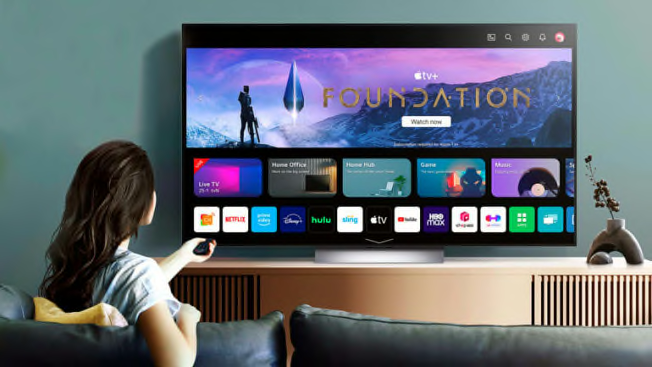
Photo: LG Photo: LG
LG B3 Series TVs
OLED TV shoppers on a tighter budget might consider LG’s new B3-series sets, the company’s entry-level OLEDs for 2023. To hit a lower price, the B3-series sets don’t get the brighter Evo panel, and they make do with a less powerful processor that doesn’t support some of the advanced picture-processing features mentioned above. These sets also have less powerful sound systems.
The trade-off, however, is that the B3 sets—offered in 55-, 65-, and 77-inch screen sizes—are priced a few hundred dollars less than the C3 models. The 77-inch B3 OLED sells for about $3,300 and the 65-inch set is $2,400.
All of these LG OLED TVs should be great for gaming, with fast response times, low input lag, variable refresh rates, and the company’s Game Optimizer, which provides quick access to all of the TV’s game presets and settings. A game dashboard overlay menu lets you access display settings, game information, and controls while you play. All of the OLED TVs come with at least two HDMI 2.1 inputs, which support all the more advanced gaming features.
LG Objet Collection Posé, Flex OLED TVs
If you’re for something unusual, check out LG’s Posé lifestyle TV line, which is being carried over in 2023. These sets are available in 48- ($1,700) and 55-inch ($2,000) screen sizes. They feature an angular, minimalist design with fabric elements, but they aren’t just cosmetically appealing. They use LG’s better Evo panels and have both front- and rear-firing speakers, so we expect them to perform well for both picture quality and sound.
For gamers looking for something different, LG’s Flex OLED TV is, as its name suggests, a flexible 42-inch OLED TV. You press a button on the remote to bend the screen into a curve for immersive gaming or return it to a flat configuration for watching TVs and movies. There are up to 20 different levels of curvature. That innovation comes at a price, though. The small set costs $2,500, or just a bit more than a 65-inch B-series OLED TV.
LG's 2023 LCD/LED TVs
Though LG’s TV emphasis this year is clearly on its OLED sets, its LCD/LED TVs are still worth considering. That’s especially true for the company’s QNED lineup. The company uses the name QNED for TVs that combine quantum dots with LG’s own NanoCell color technology (using nanoparticles as a color filter) to produce an extended range of colors. Top QNED models do well in our tests, and they might be a good choice for people who are watching TV in bright rooms.
LG QNED TVs
In 2023 the flagship QNED models appear in the QNED85 series. These are the only LG sets using Mini LED backlights with local dimming. By shrinking the size of the LEDs, TV makers can pack thousands—rather than just dozens—of LEDs into the backlights, divided into a large number of dimmable zones. The lights can also be controlled precisely. All of this can help improve contrast and black levels, and minimize halos around bright objects that appear against dark backgrounds. These sets are available in 55-, 65-, 75-, and 86-inch screen sizes, and include LG’s Alpha 7 processor, plus support for Dolby Vision HDR and Dolby Atmos sound. We’ll update pricing when it becomes available.
If you drop down to the QNED80 TVs just below these sets, you lose the Mini LED backlights and instead get edge LED backlights with local dimming, which tend not to be as effective. You also have to make do without Dolby Vision HDR and Dolby Atmos audio. In exchange, these sets (except for the largest model) have an even slimmer design. Screen sizes range from 55 to 86 inches, with prices from $1,000 to $2,800.
The entry-level QNED sets are found in the QNED75 series, which have a less powerful processor, a 60Hz refresh rate rather than 120Hz, and screen sizes that go down to 43 inches. They, too, have edge LED backlights but without any type of local dimming. They also lack HDMI 2.1 inputs. We expect pricing to be announced shortly.
For people looking for an 8K QNED TV, LG is carrying over its 65-inch QNED99 model and adding 75- and 86-inch versions in 2023. The TVs, which have Mini LED backlights, are priced from $2,500 to $4,800 for the 86-inch model.
LG UR Series TVs
This year LG has stopped using the NanoCell designation for its mainstream 4K LCD-based sets. So far, LG has announced only one new series for 2023. The UR90 TVs are basic 60Hz models with edge LED backlights, and they’re available in screen sizes from 43 to 75 inches. We expect to get prices soon.
In 2023 LG will be carrying over two lines of UQ75 sets, differentiated mainly by screen sizes. They are all basic 60Hz smart TVs. The UQ7570 models are available in 50- ($350), 55- ($400), and 65-inch ($470) screen sizes, while the UQ7590 sets come in 43- ($300), 70- ($630), 75- ($700), and 86-inch ($1,100) screen sizes.
These sets target budget shoppers. In the past, LG’s most basic TVs haven’t done all that well for overall picture quality.





























